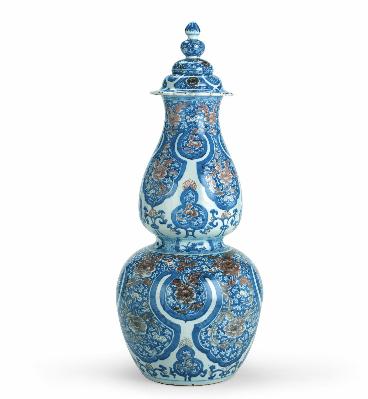
126.
VASES (TWO)
PORCELAIN DECORATED IN UNDERGLAZE BLUE AND
COPPER RED
JINGDEZHEN KILNS, JIANGXI PROVINCE
QING DYNASTY, KANGXI PERIOD (1662–1722)
HEIGHT 91 CM; MOUTH DIAMETER 16.2 CM; BASE
DIAMETER 23.5 CM (693/1)
HEIGHT 93 CM; MOUTH DIAMETER 15.9 CM; BASE
DIAMETER 23 CM (693/2)
INV. NOS. 693/1 AND 693/2
Two double gourd-shaped vases with
domed, fitted lids made in two layers and
flat rims with edges scalloped into nine
brackets, topped by a gourd-shaped finial.
Made of white porcelain and covered with
bluish glaze, except for the foot ring, the
base, the fitted edge and inside the rim of
the lids.
Both vases are decorated in underglaze
cobalt blue and copper red. Round the neck
is a large collar composed of four large
multilobed panels alternating with four
single-lobed panels, all with a wide blue
outline, filled with peonies and foliate motifs
painted in copper red on a blue ground with
foliage and flower buds reserved in white.
Below this main decoration, which is
repeated on the lower bulb of both vases, a
border with four leaf-shaped medallions
enclosing a pattern similar to the previous
ones, topped with a stylized lotus painted in
copper red and connected by stylized lotus
blossoms.
The waist of each vase is accentuated by a
band of geometric motifs, suggesting a wall,
with four oblong reserves outlined in darker
blue on the sides. The reserves on vase no.
693/1 contain an artemisia leaf, a landscape
with flowers, a fan and a landscape with
lotuses, and those on vase no. 693/2 contain
books, two landscapes with flowers and a
ruyi
sceptre.
Around the top of the lower bulb and the rim
of both vases, a zigzag border. The lids of
both vases repeat the decoration on the
body, but the finials are slightly different: on
vase no. 693/1 the finial is completely blue
with a flower head on top, while on vase no.
693/2 only the top of the finial is blue, the
flower head suggested by white lines and the
lower section is painted in red and blue like
the rest of the body.
Jar no. 693/1 is marked with a black line
on the base, and jar no. 693/2 with three
lines, probably the numbers 1 and 3 in
Chinese.
The decoration of these vases combines two
colours that fire at high temperature, cobalt
blue and copper red, so both were applied
before the vases were glazed and fired once
only, at high temperature.
Both these pigments were added to lead
glazes during the Han dynasty, the copper
red producing a green colour when fired at
low temperature in an oxidizing atmosphere.
It was only during the Tang dynasty that the
technique of firing copper red at high
temperature in a reducing atmosphere was
first used. In the late fourteenth and early
fifteenth centuries underglaze copper red
decoration was widespread, but the
difficulties encountered by potters at that
time, especially when firing this colour, led
to its replacement by overglaze enamel.
Copper red was rarely used during the
fifteenth and sixteenth centuries, and only
gradually reappeared in the first half of the
seventeenth century. During the Kangxi
reign, copper red was used on a wider scale,
both on its own on a small number of pieces,
or combined with underglaze blue – as on
these vases – where it was intentionally
incorporated into the decorative
composition.
These pieces also exemplify the difficulty in
controlling copper red, which is much more
volatile than cobalt blue, since, despite the
care employed in the decoration and the
quantity of copper used in the pigment
apparently having produced more or less the
same thickness, its colour varies between red
and dark brown.
Kangxi vases of this size and shape are rare.
There are only five other vases in similar
shape, size and decoration to these pieces,
and two smaller examples with a similar
decoration and colouring, all from the vast
and magnificent collection of Augustus the
Strong (1670–1733), currently in the Zwinger
Museum, Dresden. They are recorded in the
1721 inventory under ‘no. 10 vvv’, in the
‘Blau und Weiss Ost Indisch’ group, which
made no distinction between Chinese and
Japanese porcelain. There are two large
vases with a similar decoration in the
Museum of Decorative Arts, Madrid.
Provenance:
Private Italian collection
300 .
PORCELAIN OF THE QING DYNASTY (1644-1911)